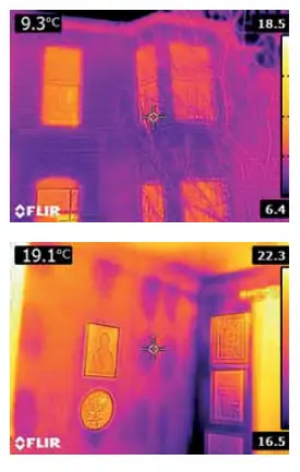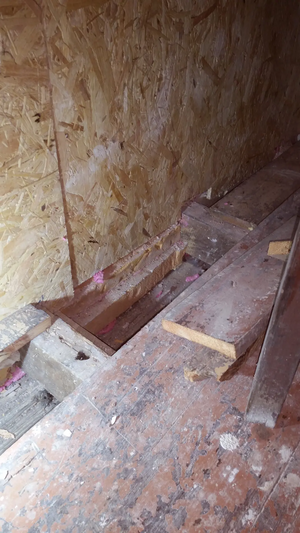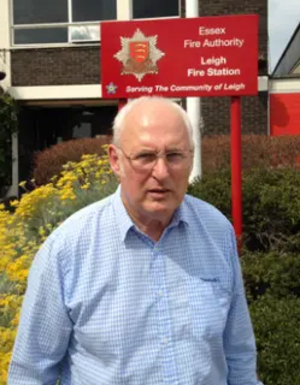Insulate Insulate Insulate - George Miles argues we need better regulation not less regulation



| I've heard the Conservatives are cutting building regulations 'red tape' on insulation etc, which were improved by our Lib Dem Ministers in the coalition - Ed Davey, Don Foster and Chris Huhne.
It makes sense to build a better house: well insulated houses are more comfortable, they will cost less to heat, saving oil, gas and CO2. But developers can build houses cheaper with less insulation, and then there's more profits for them and the energy companies. Madness. I, we, the country, the planet, cannot afford to heat every room in every big house to summer temperatures in winter. In the winter I heat just one room, and long johns are compulsory for all guests. I thought my old house would take me a year or two to do up, but I've been over ten years at it! I bought a cheap Infrared Thermometer with Laser Targeting, for about £30. It projects a red spot and tells the temperature of that spot on the wall. When it was cold outside I went around the rooms with it, getting readings and discovered the weak points in the insulation - especially the top six inches of many walls which were much thinner than elsewhere because of the slope of the roof. So this was an area to concentrate improvements on. Plus draught proofing. Because it's stone outside it would be a sin to clad it, so I'm insulating on the inside, gluing cheap seconds of Kingspan to the walls with firefoam (I tested other DIY foams with a lighter, they flame up and spread fire, like polystyrene and most plastics).
The gap between the ceiling downstairs and the floor upstairs is a problem. I'm pulling up floorboards and foaming in there. Otherwise it'd be a weak spot in the insulation, warm moist air seeping through it to the outside where it would form condensation and rot the timbers. This six inches of insulation takes more time to do than all the wall above it. I have steel beams sitting in some stonework - these form a 'cold bridge', they'd leak heat to outside and get covered in condensation, so these too are getting at least 3 inches of kingspan stuck to them with foam. All this interior detail costs time and money, most 'professionals' wouldn't bother with the unseen bits External insulationIt's far better to insulate buildings on the outside with a tight envelope. But this went tragically wrong with the Grenfell fire last summer. It sounds to me like the wrong insulation was attached shoddily, with vertical gaps left behind it which chimney-ed the fire. And why did Mayor Boris buy water canons instead of a high rise fire engine like the Americans have? Modern homes are full of flammable plastic rubbish. The solution is not to strip all external insulation from all buildings - that would cause even more deaths from cold. A tragedy that had been foreseen Deaths from fire and electrocution fall as building regulations improve. (Note - someone on UK-DIY has said that electrocutions increased after Part P regulations were tightened. I will try to find a reference for this) That's why I'm a liberal not an anarchist - I believe in Governments taxing and regulating and caring. Building Regulations aren't unnecessary red tape, they are Green Tape to protect us and make our lives better. George Miles is a member of the GLD executive | x | Grenfell background
Dense foam boards coated in zinc rainproof sheets were spaced 30mm apart across the 24-storey building, which housed 120 flats and at least 500 residents. Just two months before the Grenfell fire London Fire Brigade warned all 33 councils in the capital about the risks of cladding on tower blocks. The material used in the cladding on Grenfell was the cheaper, more flammable version of the two available options. Leaked emails seen by The Times reportedly show that Kensington and Chelsea Tenant Management Organisation (KCTMO), who managed the building on the council's behalf, saved £293,000 by downgrading the material used to clad the 1970s tower. The cladding's manufacturers clearly state in its brochure that it should not be used on a building above a height of ten metres (32ft), according to the Express. In November Cllr Peter Wexham wrote :"As long ago as 2013 I urged Southend Council to change the Building Regulations so as to insist on sprinklers. But Council officers explained that without new powers from the Government, changed Building Regs could not be enforced. As a member of the Fire Authority I have seen what a huge difference having sprinklers can make. Why is the Government still dragging its feet on giving Councils these powers which will save lives?" |
- References:
- https://www.thegreenage.co.uk/external-wall-insulation-versus-internal-wall-insulation/
- Solid wall heat losses and the potential for energy saving consequences for consideration to maximise SWI benefits:A route-map for change :
https://www.bre.co.uk/filelibrary/pdf/projects/swi/UnintendedConsequencesRoutemap_v4.0_160316_final.pdf - There is a discussion going on about this on UK-DIY newsgroup, a fantastic online community of people wome with great experience of DIY matters plus a few trolls, nutters, and UKIPers ! The discussion has digressed to a discussion on whether to demolish all old houses and rebuild with high insulation standards etc etc.
https://groups.google.com/forum/#!topic/uk.d-i-y/Z34Bc9lTHho
From page 16 of Challenge Magazine Winter 2017
https://greenlibdems.org.uk/insulate
